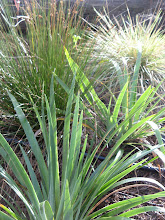
While I currently work in a public garden, I have never had a garden of my own, except for my collection of houseplants. When I first became hooked on houseplants, my collection grew rapidly...until I moved to Flagstaff (from Arcata, CA). Almost all of my plants went to my parents' house where they now struggle to survive. Selecting plants to take with me was a major weeding process. In the end I took only five plants and have acquired only one since living in Flagstaff. Here is my garden:
Selenicereus chrysocardium, a cactus that grows on rainforest trees. My sister Megan bought this for me at the San Diego Wild Animal Park as a Chrismas present. There are a few individuals in this pot (propagated from cuttings). I hope that it flowers one day (I hear that it has plate-sized white flowers that open at night and die the next day).

This plant is Crassula lycopioides. I used to volunteer at the greenhouse at HSU and had my eye on this plant. A friend gave me some cuttings before I left. I like how it looks like a clubmoss (Lycopodium spp.), but is a succulent flowering plant from South Africa. Convergent evolution. Clubmosses are difficult to obtain ethically and are hard to cultivate so this makes a fine substitute. I like plants that are somehow symbolic. To me this plant reminds me of the primitive club moss, the deserts of South Africa, evolution, and coral (especially with the fish motif on the bowl). The cactus above looks like a fern, but it too is something completely different. That fascinates me.
This is Euphorbia bupleurifolia, probably my favorite houseplant. Some people call it the Pineapple Euphorbia. Euphorbias are remarkably diverse; its a genus that tempts me to collect. It's been doing well in the warmth of Flagstaff, producing many leaves and even developing its first mature inflorescence. I bought this at the Arcata Farmer's Market one Saturday. It's another South African succulent.

This is a
Heuchera (
rubescens?) from near the top of Mount Humphrey, the tallest peak in Arizona (it’s the tallest of the San Francisco Peaks, pictured in a couple of posts back). It’s a creeping, rhizomatous species that is abundant up there so I didn’t feel too guilty about taking a small piece. Eventually this plant will become a compact bun of green leaves with tall airy pink inflorescences. It's grown quite a bit already. I was compelled to read about alpine plants and rock gardens after hiking to the top of Mount Humphrey. Members of the Saxifragaceae are another group of plants I would consider someday collecting, as there are many native California species and most are easily propagated by division. This plant has adapted well to the window sill despite being initially pawed out repeatedly by my roommate’s cat. It is now closely monitored. I made the pot during my first semester at HSU.

My two other plants include an Ondontoglossum orchid that blooms around Christmas time (yellow with maroon spots). The other plant is a common jade plant I propagated from a leaf from the HSU library. It’s large now and has some sentimental value, though it’s not particularly interesting.
I need to live in a place with a yard or balcony for at least a year so I can start growing some vegetables. Zucchinis and tomatoes for starters. Someday I will realize my dream garden which includes a modest vegetable and fruit garden (with lots of raspberries and blueberries), a native woodland, a pond, and a bog filled with interesting native sedges, orchids, ferns, and monkeyflowers. In the near future I plan on growing many of these plants in preparation.
Words to describe my ideal garden include fresh, lush, indigenous, Arthurian, primeval, medieval, ethereal, dark, serene, mythological, historical, paleontological, practical, productive and real.






























